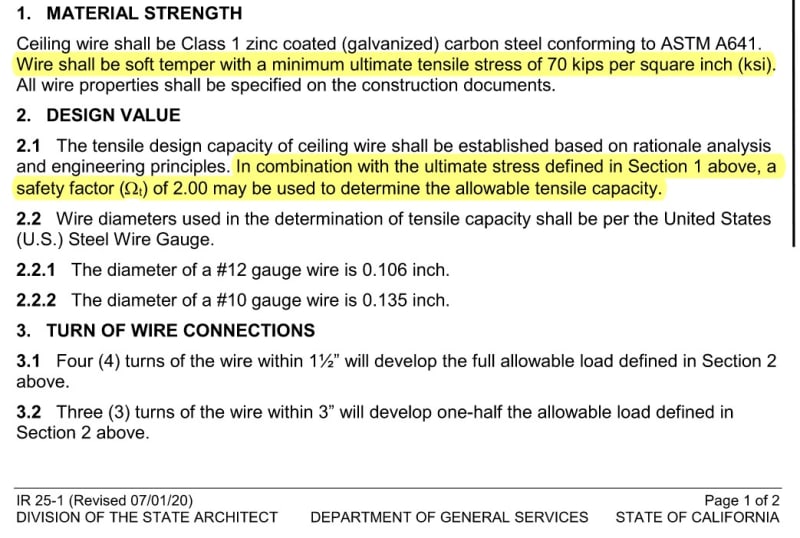skeletron
Structural
- Jan 30, 2019
- 880
12ga (0.1055" diameter) wire is commonly used for brace wires of suspended ceiling.
[ul]
[li]Manufacturers like Clark Dietrich give a break strength (375 lbs) and then a safe work load (94 lbs). The SWL is the break strength divided by 4. CD lists the tensile range as 50ksi to 65ksi[/li]
[li]USG also provides a yield point (424 lbs) and an ultimate load (+550 lbs), both slightly higher than the break strength from CD[/li]
[li]USG also provides a value for "wire tie failure/pullout failure" of the tight-3 wrap tie (358 lbs) which is ~95% of the break strength from CD[/li]
[li]Grabber Pro lists an even higher typical capacity (600 lbs) as well as a yield stress (59ksi) and tensile max stress (75ksi)[/li]
[/ul]
The ASTM standard for "galvanized carbon steel wire" is ASTM A641 and lists the following tensile strength for temper designation:
Soft = 70 ksi (max)
Medium = 65 ksi to 90 ksi
Hard = 80 ksi to 110 ksi
For vertical hanger wires, no problem...I'm using the SWL = 94 lbs with no problems and no reason to change.
For splay wires in a reasonably high seismic zone, the calculations are suggesting that 12ga shouldn't really work unless the FOS is modified to a somewhat low range.
My questions:
1. How is everyone arriving at the capacity of the 12ga splay wire, and is it different than the SWL or the capacity used for the vertical wires?
2. Is it reasonable to back calculate a "dynamic capacity" for the 12ga wire based on an ultimate stress or tensile strength? In this case, what is the stress that is appropriate?
3. Is this just a case of 9ga or 1/8" aircraft cables being the better solution than the FEMA E-74 generic detail?
I've come across some other competitors that have used 9ga wire (super hard to twist)and 1/8" cable (more expensive, but easier to inspect and install). But I've also come across another prominent firm using the 12ga wire for high importance structures, which doesn't make sense by my research. What says you anonymous 'geers?
[ul]
[li]Manufacturers like Clark Dietrich give a break strength (375 lbs) and then a safe work load (94 lbs). The SWL is the break strength divided by 4. CD lists the tensile range as 50ksi to 65ksi[/li]
[li]USG also provides a yield point (424 lbs) and an ultimate load (+550 lbs), both slightly higher than the break strength from CD[/li]
[li]USG also provides a value for "wire tie failure/pullout failure" of the tight-3 wrap tie (358 lbs) which is ~95% of the break strength from CD[/li]
[li]Grabber Pro lists an even higher typical capacity (600 lbs) as well as a yield stress (59ksi) and tensile max stress (75ksi)[/li]
[/ul]
The ASTM standard for "galvanized carbon steel wire" is ASTM A641 and lists the following tensile strength for temper designation:
Soft = 70 ksi (max)
Medium = 65 ksi to 90 ksi
Hard = 80 ksi to 110 ksi
For vertical hanger wires, no problem...I'm using the SWL = 94 lbs with no problems and no reason to change.
For splay wires in a reasonably high seismic zone, the calculations are suggesting that 12ga shouldn't really work unless the FOS is modified to a somewhat low range.
My questions:
1. How is everyone arriving at the capacity of the 12ga splay wire, and is it different than the SWL or the capacity used for the vertical wires?
2. Is it reasonable to back calculate a "dynamic capacity" for the 12ga wire based on an ultimate stress or tensile strength? In this case, what is the stress that is appropriate?
3. Is this just a case of 9ga or 1/8" aircraft cables being the better solution than the FEMA E-74 generic detail?
I've come across some other competitors that have used 9ga wire (super hard to twist)and 1/8" cable (more expensive, but easier to inspect and install). But I've also come across another prominent firm using the 12ga wire for high importance structures, which doesn't make sense by my research. What says you anonymous 'geers?

